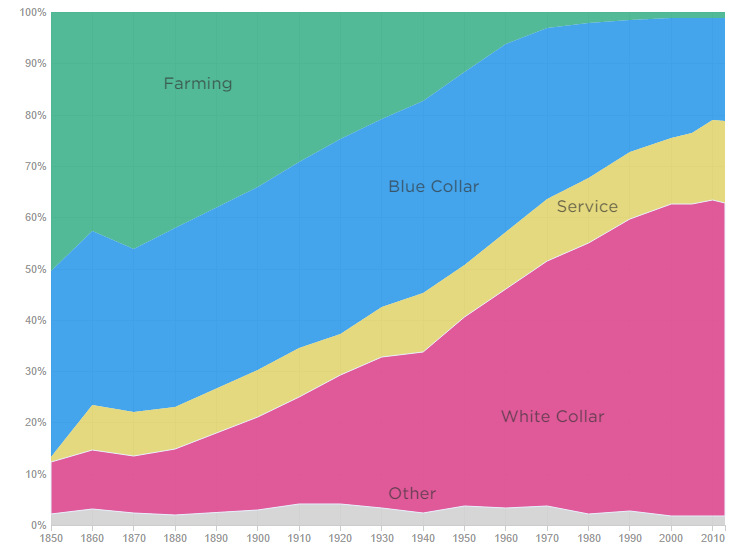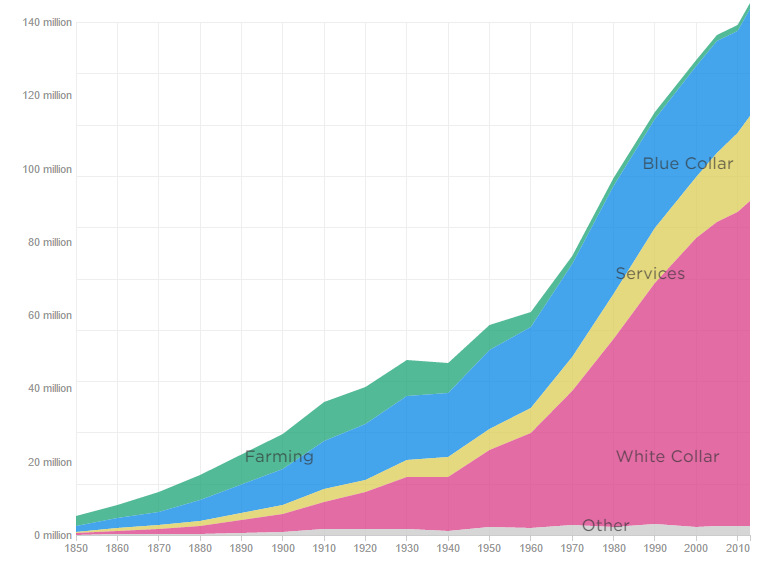Technology
How Machines Destroy and Create Jobs
“There’s just doesn’t seem to be many blacksmith jobs these days.”
At first glance, this would be a ridiculous thing to say. Of course there aren’t many blacksmiths around. We live in a modern society and machines do a way better job of making things from metal anyways.
However, it also raises an important point.
What if machines are better at driving long-haul trucks? What if machines are better servers at McDonald’s? What if robots did your taxes for you?
While some of these ideas are contentious today, in the future we may look back thinking that our fears were ill-placed. The truth is that the job landscape is constantly in flux as technology changes.
Some of today’s jobs with high automation potential may be the future “blacksmiths”, and we should not be surprised if they go away. The best thing that we can do is to understand these trends and build a set of skills that will be in demand in any market.
The Trend is Your Friend
The following graphics from NPR shows the evolution of jobs over time in the United States.
The first divides jobs into four main categories: white collar, blue collar, farming, and services. It shows how the composition of the overall job market has changed over the last 165 years:

The second shows the same information, but plotted by the total number of jobs:

There were 10 million farmers in America in the early 20th century.
Now there’s closer to one million, and yet those farmers produce way more food. Technology may have “killed off” the majority of farm jobs, but at the same time new technology created jobs in the service, blue collar, and white collar industries.
We may now be at a similar inflection point for other careers – this interactive graphic shows some of the jobs that have been on the decline in recent years.
In 1960, a whopping 11% of the workforce was employed in factories. Today only 4% are employed in factories.
In the late 1970s, almost 5% of the workforce was secretaries. Today, we’re at about half that, but professionals can be just as productive without a secretary thanks to better computer software.
Yes, there are globalization issues at play here as well, but even a modern domestic factory such as the Tesla Gigafactory (which has the largest building by footprint in the world) will only employ about 6,000 people. The majority of the work will be done by robots.
And while it seems scary to think about the rise of machines and a faster pace of technological advancement, it’s important to recognize that these types of sweeping changes to the job market have happened throughout history.
The point is, try not to be the 21st century version of a “blacksmith”.
Technology
Visualizing AI Patents by Country
See which countries have been granted the most AI patents each year, from 2012 to 2022.

Visualizing AI Patents by Country
This was originally posted on our Voronoi app. Download the app for free on iOS or Android and discover incredible data-driven charts from a variety of trusted sources.
This infographic shows the number of AI-related patents granted each year from 2010 to 2022 (latest data available). These figures come from the Center for Security and Emerging Technology (CSET), accessed via Stanford University’s 2024 AI Index Report.
From this data, we can see that China first overtook the U.S. in 2013. Since then, the country has seen enormous growth in the number of AI patents granted each year.
| Year | China | EU and UK | U.S. | RoW | Global Total |
|---|---|---|---|---|---|
| 2010 | 307 | 137 | 984 | 571 | 1,999 |
| 2011 | 516 | 129 | 980 | 581 | 2,206 |
| 2012 | 926 | 112 | 950 | 660 | 2,648 |
| 2013 | 1,035 | 91 | 970 | 627 | 2,723 |
| 2014 | 1,278 | 97 | 1,078 | 667 | 3,120 |
| 2015 | 1,721 | 110 | 1,135 | 539 | 3,505 |
| 2016 | 1,621 | 128 | 1,298 | 714 | 3,761 |
| 2017 | 2,428 | 144 | 1,489 | 1,075 | 5,136 |
| 2018 | 4,741 | 155 | 1,674 | 1,574 | 8,144 |
| 2019 | 9,530 | 322 | 3,211 | 2,720 | 15,783 |
| 2020 | 13,071 | 406 | 5,441 | 4,455 | 23,373 |
| 2021 | 21,907 | 623 | 8,219 | 7,519 | 38,268 |
| 2022 | 35,315 | 1,173 | 12,077 | 13,699 | 62,264 |
In 2022, China was granted more patents than every other country combined.
While this suggests that the country is very active in researching the field of artificial intelligence, it doesn’t necessarily mean that China is the farthest in terms of capability.
Key Facts About AI Patents
According to CSET, AI patents relate to mathematical relationships and algorithms, which are considered abstract ideas under patent law. They can also have different meaning, depending on where they are filed.
In the U.S., AI patenting is concentrated amongst large companies including IBM, Microsoft, and Google. On the other hand, AI patenting in China is more distributed across government organizations, universities, and tech firms (e.g. Tencent).
In terms of focus area, China’s patents are typically related to computer vision, a field of AI that enables computers and systems to interpret visual data and inputs. Meanwhile America’s efforts are more evenly distributed across research fields.
Learn More About AI From Visual Capitalist
If you want to see more data visualizations on artificial intelligence, check out this graphic that shows which job departments will be impacted by AI the most.
-

 Markets1 week ago
Markets1 week agoU.S. Debt Interest Payments Reach $1 Trillion
-

 Markets2 weeks ago
Markets2 weeks agoRanked: The Most Valuable Housing Markets in America
-

 Money2 weeks ago
Money2 weeks agoWhich States Have the Highest Minimum Wage in America?
-

 AI2 weeks ago
AI2 weeks agoRanked: Semiconductor Companies by Industry Revenue Share
-

 Markets2 weeks ago
Markets2 weeks agoRanked: The World’s Top Flight Routes, by Revenue
-

 Countries2 weeks ago
Countries2 weeks agoPopulation Projections: The World’s 6 Largest Countries in 2075
-

 Markets2 weeks ago
Markets2 weeks agoThe Top 10 States by Real GDP Growth in 2023
-

 Money2 weeks ago
Money2 weeks agoThe Smallest Gender Wage Gaps in OECD Countries














